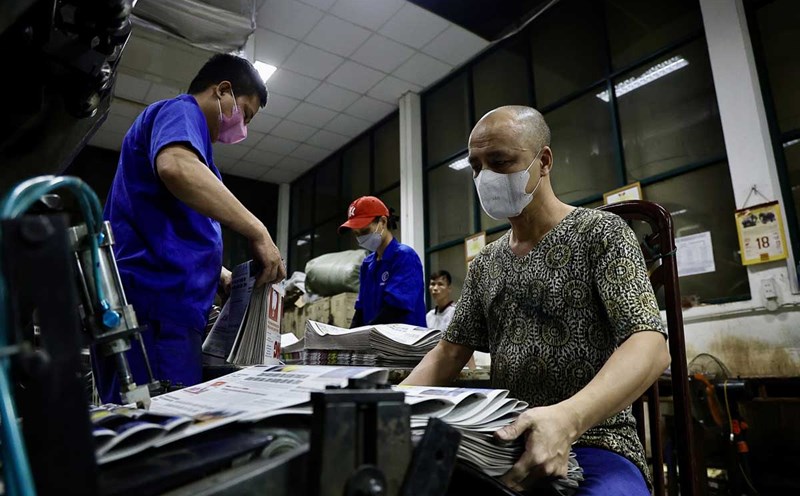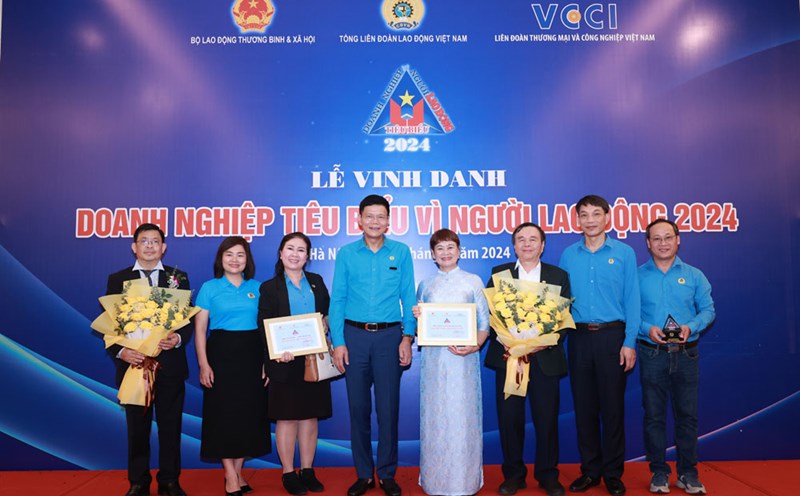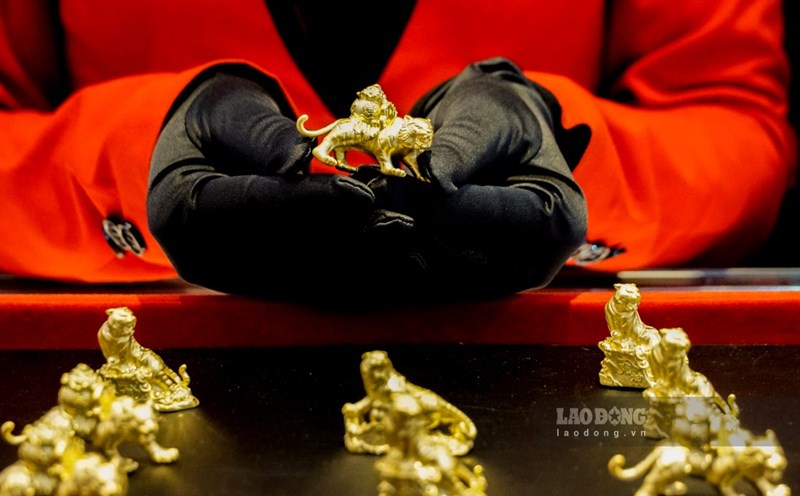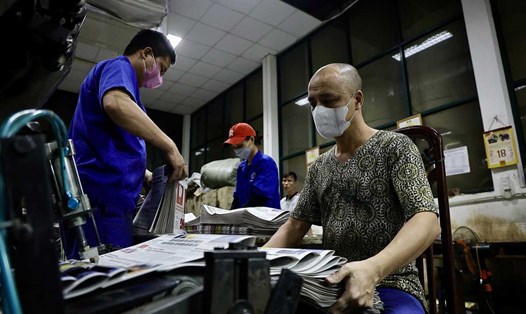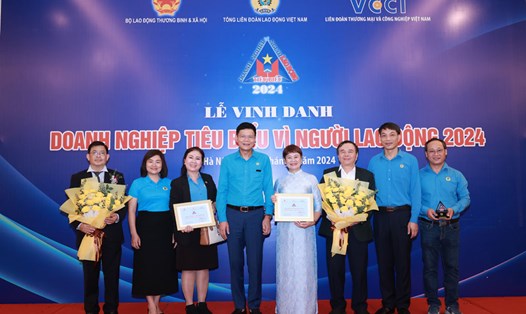Joining the nation's August Revolution
In 1944, the Central Committee of the Workers' Association for National Salvation decided to secretly publish Lao Dong newspaper as the association's propaganda agency. The history book Lao Dong Newspaper records the story of comrade Nguyen Van Tran - the person assigned to oversee journalistic work: "On August 5, 1943, I and three comrades escaped from Son La prison. At the beginning of October, Mr. Truong Chinh, General Secretary of the Party Central Committee, assigned him the task of taking charge of the public transport work in Tonkin along with nine other brothers and sisters. When assigning tasks, Mr. Truong Chinh also assigned him to publish a newspaper.
He said: The Party already has the Liberation Flag newspaper, the Viet Minh side has Cuu Quoc newspaper, now Workers for National Salvation must have a newspaper. At that time, the labor movement was developing strongly, there was a shortage of officials, and publishing newspapers was very difficult. There is no printing press, there is no money, there is no writer; Yet the newspaper was only able to be published thanks to revolutionary enthusiasm and reliance on workers. When discussing the naming of the newspaper, I honestly did not know that in 1929 there was a Lao Dong Union newspaper.
I remember someone telling a story that in the Soviet Union, the trade union had the newspaper Lao Dong. So I took that name and gave it to my newspaper.
There's no one in the newsroom, everyone has to write the news. If they can't write, they tell it for someone else to copy. Newspapers mainly publish news. Where do you believe the bosses will fine you and kick you out? Wherever there is struggle; There is support for the revolution. Occasionally, a folk song or rhyme is inserted to make it easier to remember.
After preparing the article, we took everyone to Phuc Yen, where there was a secret printing facility of the Party, there someone edited the news, presented it, and made it into a newspaper. Lithographic printing means writing letters upside down on the stone surface with special ink. After printing, it was handed over to workers to save the country for distribution. That means distributing to facilities in Hanoi, Hai Phong, Vinh Yen, Dap Cau...
I worked as a county transport officer for half a year, then Mr. Van Tien Dung, Secretary of the Party Committee, was arrested and I had to replace him. The work of workers saving the country was left to Mr. Ha Ke Tan. Lao Dong Newspaper continues to appear.
From the end of 1943 to the uprising on August 19, 1945, there were 12 issues. It was a feat. Print as many as you can and release them all. Unfortunately, there is no longer a single newspaper left as a souvenir or museum.
When the revolution was rumbling, no one thought about it. In addition, in the year Forty-Five, I was worried about both the movement and hunger. I remember in particular, in April of the Forty-fifth year, the Workers to Save the National Assembly commanded the poor to destroy Japanese rice warehouses in Bac Ninh town three times. In the Hanoi area, rice warehouses were destroyed near Pig Furnace, at Black Ferry Wharf, in Lang and Moc.
In Hai Phong, workers secretly destroyed food warehouses at Sau Kho wharf, creating conditions for poor people to get in. On the day of the uprising, the floodwaters flooded. So many precious documents were still swept away by the flood. Today the only trace of that journalistic period is this.
After the success of the August Revolution, the government returned to the working class, the headquarters of Workers to Save the National Assembly was located at 51 Hang Bo Street, Hanoi, that place was originally a printing house, the printing facility was still intact, Mr. I decided to publish Lao Dong Newspaper publicly. And the first issue of Lao Dong newspaper that appeared after the August Revolution was serially numbered 13, until today. I remember that number 13 came out around the end of October 1945.
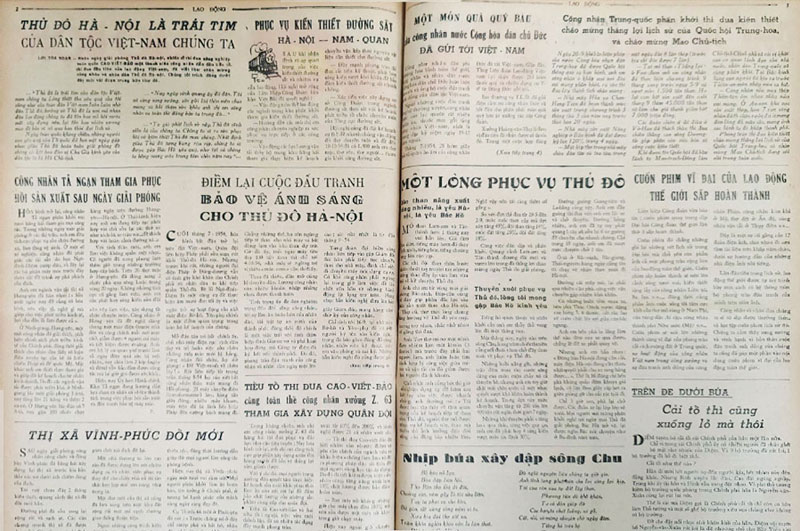
The first public issue of the newspaper after the August Revolution on October 18, 1945 was because a week later, on October 25, a historic event would take place: the Conference of Representatives of Workers for National Salvation in North Vietnam at the Hanoi Opera House. Noi. This was the first conference of revolutionary organizations after the August Revolution. I remember comrade Vo Nguyen Giap attending. Lao Dong Newspaper came out to prepare for that event. The first issue was published with clear typography, but there were only 1,500 copies. The latter issue has released up to 10,000 copies.
On the cuff of the first issue published after the day of the General Uprising were the words: LAO DONG
- Second year. Number 13. Price 0d30. Released on October 18, 1945. Propaganda agency of Vietnam Workers for National Salvation in the North (in the Viet Minh). Editorial and Administration Office: 51 - Hang Bo. Wire says: 547. Published on Thursday. Letters, checks, and papers should be sent to: Tran Luu Trac.
The newspaper has two pages, size 45x35 cm. On page 1, the newspaper wrote: “Labour will actively attack the destructive policies of counter-revolutionaries, will meticulously study the situation and aspirations of workers in factories, plants, and mines; will clearly outline the tasks of workers in the current period, will be a common forum for all Vietnamese workers. Lao Dong is a close friend of workers in the fight to maintain the independence of the Fatherland."
It is worth mentioning that during this time, musician Van Cao participated in the Lao Dong newspaper. The history book Lao Dong Newspaper records the words of musician Van Cao: "I have the honor that after the August Revolution, when Lao Dong Newspaper published its first public issue, I was present. Before that, I worked at Doc Lap newspaper. I had a secret working relationship with Mr. Tran Danh Tuyen and Mr. Nguyen Huu Mai, so when Mr. Tuyen in charge of Lao Dong newspaper invited me, I immediately left. Every day I work directly with him at 51 - Hang Bo, headquarters of Lao Dong Newspaper. I write articles and stories while also taking care of printing. The printing house is on the first floor. After discussing work upstairs, I immediately went down to join the workers. And all day, even all night there.
The printing house lacks everything, colors and ink are not available. The font is shabby. We have to search and search for anything that can be used. What must be done to make the newspaper print beautifully? Unfortunately, I had to go get a new typeface (serif typeface) from my future father-in-law's Rang Dong printing house. Having good words then having to find a way to present them beautifully, clearly, brightly...
Before me, I was the composer, wandering around on the streets all day. Now, from morning till night, I hang around the table and computer; On the side of the workers... also keep up with mo-rat editing (editing proof copies). Even though it was hard, I felt very happy, I didn't know what it was like to be tired... The Lao Dong newspaper was printed very beautifully, with the best serif letters at that time."
Contributed to the victory of Dien Bien Phu "famous in five continents, shaking the earth"
Sharing the same atmosphere of the entire nation before the victory of Dien Bien Phu, the Lao Dong newspaper in those days was also vibrant with an atmosphere reflecting optimism, faith and pride.
The Lao Dong newspaper issue dated May 1, 1954 had a solemn article about "The 1953 achievements of the convoy serving the Dien Bien Phu campaign", the article had a very touching paragraph: "Once when the convoy arrived there ( road X-PV) when they encountered enemy aircraft in action, every 10 minutes they circled around, threw bright flares and bombs to destroy the road. Thinking about the soldiers fighting on the front lines, they still faced more danger than that but still overcame them, thinking about the tasks given by the Party and President Ho Chi Minh, if they were not delivered in time, it would make it difficult for the soldiers to kill the enemy. Therefore, we are determined to find a way to overcome this road...".
In the issue dated May 19, 1954, on Uncle Ho's birthday, Lao Dong Newspaper published a letter from the Vietnam General Confederation of Labor to the comrades, officers, soldiers and citizens of Dien Bien Phu: "Brothers and sisters, workers , the nation's labor force was extremely excited at the great victory at the Dien Bien Phu front, sending to comrades, officers, soldiers and citizens our gratitude and congratulations for the victory.
...For the future of the country, for the happiness of the people, for the lasting peace of the world, you comrades have not hesitated to sacrifice blood, no matter the hardships and difficulties, to uphold the spirit of determination and determination. victory that President Ho has taught to his comrades.
Workers and laborers nationwide are willing to learn from their comrades, and strive to strengthen competition in all aspects, with fellow farmers in the fields and with soldiers at the front to promote the patriotic struggle to complete victory. ”.
Head to Hanoi
Lao Dong history books record: May 7, 1954, the great Dien Bien Phu Victory. On July 20, 1954, the Geneva Agreement on peace in Indochina. On October 10, 1954, the Vietnam People's Army took over the capital Hanoi.
Those are milestones on the country's jubilant journey as well as in the history of Lao Dong Newspaper. The newspaper paused for more than a month to prepare for publication in the capital.
Lao Dong Newspaper reporters were present in the army marching to their beloved city. The city is full of homeless houses but they have no place to live. Former Editor-in-Chief of Lao Dong Newspaper Le Dinh Van (then Editorial Secretary) had to ask for directions to get to the house at 51 - Hang Bo.
Issue 273, published on October 10, 1954, had a big headline on the front page: Welcome to the Liberation Capital. The article reads: "Today under the light of peace and the bright red flag with yellow star, from our beloved Capital, we send greetings to the working class and people of our countries and the world who have always supported us." support us, cheer us on, and help us enhance our fighting power to achieve victory today.
Liberated capital, our workers and people of Hanoi have entered a new phase of activity: standing side by side with all the people to make the capital forever peaceful, bright and increasingly prosperous...".
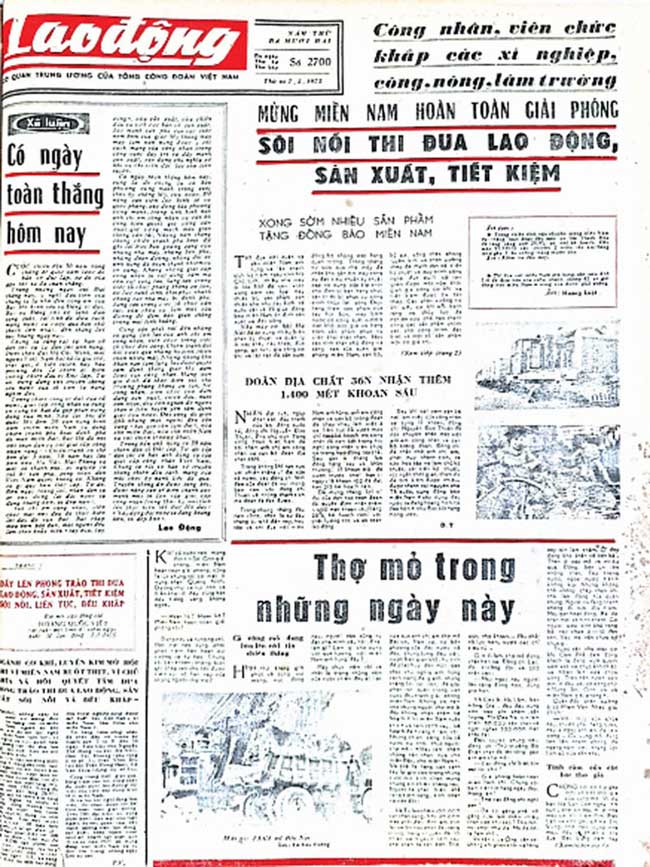
In the same issue of the newspaper, Lao Dong quoted a letter from national industrial emulation fighter Cao Viet Bao - a young worker leading the first emulation sub-group of Vietnamese Labor who wrote a letter to welcome workers and People of Hanoi Capital. The letter said: “From this historic moment, the Capital is forever ours. We will try our best to restore and rebuild the Capital quickly. Surely in the bustling Capital, we will be able to meet our beloved Uncle Ho as we have all wished for these eight or nine years."
This is one of the last issues of Lao Dong newspaper printed in the war zone. The first issue of the newspaper released to the Hanoi public was number 276 on November 6, 1954, nearly a month after the capital's liberation. Eight pages, size 52 x 35cm, published weekly on Saturdays. Right on the first page, the reportage has a title like a shout of joy: "The first train on the Hanoi - Hai Duong route liberated!" And like a shout of joy, right in this issue, the newspaper published the novel "The Mine" by Vo Huy Tam, 3 consecutive issues. The newspaper continued the column with the very name "on the anvil under the hammer" and gave a strange impression to Hanoi readers, the column specialized in beating and exposing the plots and tricks of the enemy. The newspaper opened the section "Common knowledge about unions" starting with the question: "What is a union?" to equip workers, laborers and people nationwide with knowledge about trade unions
Contribute your efforts to National Unification Day
April 30, 1975, the day of victory of Ho Chi Minh's historic campaign to liberate Saigon and the South, was also the day that marked the change in the fate of millions of people. The country entered a new era.
Sharing the country's atmosphere, Lao Dong Newspaper reflected the joy of the entire nation, encouraging people from all walks of life to participate in promoting production and building the country.
Issue 2698, published on April 30, 1975, published a propaganda painting by artist Huy Oanh and the editorial "Forward with the spirit of May 1 and the spirit of victory." The editorial read: "The recent victory of the Southern compatriots and soldiers is creating a new and very good situation, the forces of the revolution are overwhelming the enemy. Their downfall is inevitable. All Southern compatriots and soldiers are rushing towards complete victory. The new revolutionary situation places new and very urgent demands on the working class and our people."
Above the cufflinks, Lao Dong Newspaper quoted President Ho Chi Minh as saying in May 1962: "Every ton of coal, every factory, every quintal of food... that we increase and save will help speed up the pace." The level of building socialism in the North is all about supporting the heroic struggle of the people of the South, and all is contributing to the peaceful reunification of the country."
Below is an article with the headline "For the sake of the South, in competition, each person works twice as hard."
Issue 2699 issued on May 3, 1975 solemnly published the atmosphere of victory with the headline: "Welcome the glorious victory of the people of our country to COMPLETELY LIBERATE THE SOUTH" with the slogan: "Raise the competition movement." The race for labor, production, and savings is vibrant, continuous, and even.
This is the issue of the newspaper that publishes the reportage "Steel Night" by two writers Xuan Cang and Tong Van - two writers who later became Editors-in-Chief of Lao Dong Newspaper. The reportage read: "Happily we are here on the night of Ho Chi Minh's complete victory, a night of steel. Since the afternoon, tens of thousands of iron and steel workers have sounded their horns, the whistles lasted as if they never ended, and burst firecrackers, and cheered.
* * *
Lao Dong Newspaper contributed to the golden pages of Vietnam's revolutionary history. Not only are there classes of reporters who volunteered to go to the battlefield and there were people who sacrificed for the country such as Deputy Editor-in-Chief Vo Van Ngoan, reporter Le Ai My... but also articles that encouraged and encouraged the fighting spirit. , the spirit of production recovered and the country was built.
Lao Dong Newspaper has truly accompanied and advanced with the country so that the current generation of reporters is still proud of Lao Dong Newspaper, keeping within its glorious tradition.

